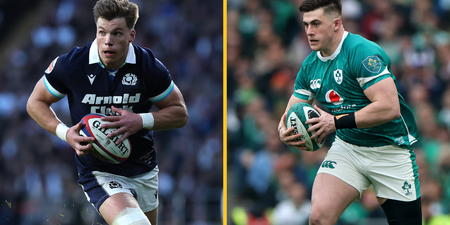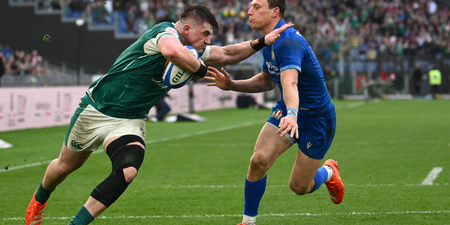Conor McGregor vs Nate Diaz was one of the most intriguing fights in UFC history.
McGregor had crushed everything in his path in the UFC and was coming off a 13 second KO of one of the organisation’s most imperious champions in Jose Aldo.
The featherweight juggernaut was set to step up and fight lightweight champion Rafael dos Anjos, but when he pulled out injured Nate Diaz stepped in with 10 days notice.
McGregor vs Diaz was the Octagon war every fan wanted to see, but what gave the fight an extra edge was that the Notorious agreed to take the fight at welterweight – a whole 25lbs heavier than when he won the featherweight strap.
It was pitched as a battle between McGregor’s devastating left hand and the dexterous, crafty boxing and elite jiu-jitsu of Diaz.
Many believed the Irishman could KO Diaz – a man knocked out only one time in his career, while others had tipped the Stockton native for the win.
Not even the bookies could call it – and you could get 8-1 odds on a second-round submission by the Stockton fighter.
After a dominant first round by McGregor, that’s exactly what happened – he took a couple of heavy shots in the second, took Diaz down and ended up tapping after a rear naked choke.
So what went wrong for McGregor? Were there lessons the Dubliner could take from his first UFC defeat if the pair are to rematch at UFC 200?
We spoke to Ben Crighton, who is a PhD sports scientist in Mixed Martial Arts with a specialism in weight cutting, at the EA SPORTS UFC 2 ‘Finish the Fight’ launch event.
What were your thoughts on the fight from a sports science perspective? McGregor moved up and fought nearly 25lbs heavier than the Aldo fight – how did it affect his performance?
Obviously he put on a fair bit of size on to move up from featherweight to welterweight. He fought at 168lbs.
You could see with him on fight night, he wasn’t necessarily as lean as he has been in previous fights – simply because he had no weight to cut.
He was a little bit heavier than he was probably used to being. When some guys pack on muscle mass they tend to have a little bit of a problem with energy expenditure and, as you saw in the fight, he tended to gas out a little bit quicker than he would normally.
It’s difficult to speculate, because that could be down to the fact he’s put size on. He’s packed on more muscle and obviously the more muscle you have, the more oxygen that muscle needs and the more glycogen that muscle needs.
It just could just be because at the time, like he said, he was loading up all those punches.
You see it quite often in the UFC. You see these guys who are fast-twitch muscle fibre fighters or explosive power based fighters like Tyrone Woodley, for example. It’s just not really possible for those guys to explode with 100% power all the time with every strike.
Was there anything in his preparation which might have influenced how the fight went?
I’m a big fan of his movement coach Ido Portal. I’ve followed him for a number of years now before he started working with McGregor.
But when you watched the UFC Embedded series, some of the stuff he was doing a few days before the fight (well, the way they put it across it was only a few days before the fight) he was doing muscle-ups on the rings and they are extremely taxing.
If you think how much upper body is involved with that, your shoulders and everything are going to get seriously fatigued there.
I wonder whether something as simple as such a strenuous workout three days before fight night could mean you just haven’t got as much gas in the tank and your muscles just aren’t as fresh as they could have been.
The combination of that, with the extra muscle mass and the fact he was loading up on shots so much maybe led him to gas out, which was a surprise to me.
Do you think he approached the fight correctly from a tactical perspective?
From a tactical point I was a bit disappointed. It’s easy for me to say this, because I’m not the guy in there.
I was expecting a lot more body shots and I was expecting him to throw the spinning back kick a lot more to the body.
I think he threw three spinning back kicks in the whole fight and two of those were really wheel kicks to the head. I thought he was going to wear Diaz out to the body but he seemed to head hunt a bit. He’s even come out and said that himself.
With regards to him gassing, the factors we talked about before resulted in him gassing.
But I also think the mental side is massive. Once you’ve landed a couple of your best shots on someone and they don’t seem to be fazed by it you can start to doubt yourself and the fatigue sets in and that’s kind of the beginning of the end.
What do you think might have been the most prominent factor that affected his not only his power, speed and conditioning – but also his energy levels?
It’s really the combination of things. The extra weight – because obviously you’re putting size and muscle on and it takes time to build a gas tank up to supply those muscles with oxygen.
You need to make sure you’ve got enough mitochondria there to supply the muscles with oxygen and fuel.
The what-looked-like intense training sessions in the days before and the loading up on shots and the mental factor that maybe sent him over the edge.
I’ve watched the fight a few times now but it didn’t appear to me that the pace he put up was higher than the pace in previous fights.
But he threw so many heavy shots and that doesn’t half sap your strength.
From a sports science perspective what would have been a better approach to this fight? Was stepping up two weight classes too much too soon? Should he have worked on building up his cardio at that bigger weight?
It’s hard to say without seeing his actual training. For all we know those muscle ups he was doing might have been two or three weeks before the fight, so it’s hard to comment.
I know his coach John Kavanagh, I’ve spoken to him before and he’s very knowledgeable about the game. So I’m sure that side of things are dialled in. It’s hard to say from a sports science perspective without being involved in the actual fight camp to see what they’ve been doing.
I don’t think it was a bad decision to step up and fight Diaz at 170lbs. Okay with hindsight you’d probably have made them have a catchweight bout at 160 or 165.
But looking at the fight, McGregor gets the best of Diaz in the first round and he gets the better of him for the majority of the times in the second.
Even the shot that he takes Diaz down with was a good shot. It was a better shot than I expected McGregor to have on him. It’s just the fact that Nate Diaz’s jiu jitsu is so slick.
It’s a bit like the Ali-George Foreman scenario that when you get that fatigue that anyone is going to be able to knock you out.
The same with McGregor. Once you’re that fatigued on the bottom, it’s so difficult to defend especially against someone with jiu-jitsu as elite level as Diaz’s is.
Flipping it around, if you’re Diaz, how do you get in such good condition in just 10 days for a five-round fight against a man like McGregor?
I think if you look at both the Diaz brothers they’re some of the best-conditioned athletes around with regards to output.
Even though he may not have been training for a triathlon at the time, they have done them in the past.
Nick swam from Alcatraz a couple of times. He did it once for charity and again just for the hell of it. It just goes to show how well conditioned they are.
If you’ve got an older brother like Nick you’d have to work pretty hard not to get bullied in the gym. Nate and Nick are unique in that respect.
The Diaz brothers are both pitter-patter fighters. So it’s constant punches at 50, 60 or 70% but because you’re not throwing everything into every punch you don’t seem to be fatigued in the same way, plus probably for the last 15 or 20 years they’ve been doing high intensity sports.
Genetic factors and plus their work rate and the fact they enjoy that kind of cardio. If you’ve got the aerobic capacity to compete in things like the triathlon, I think taking the fight on 10 or 11 days wasn’t too much of an issue for Diaz.
This is because he’s built up such a great aerobic capacity and also the fact that’s he’s not the sort of fighter that explodes and burns himself out.
One interesting thing from the Diaz camp was that they got him doing short duration, high intensity sessions multiple times a day over the 10 days. Is this a faster and more effective way of building up your cardio and endurance?
I would say generally speaking, yes. A lot of the old school methods from back in the day, like where boxers would get up and do a lot of road work, running for long periods of time at low intensity, doesn’t really carry over into MMA-specific type of energy systems.
I think if you can do high intensity training sessions, multiple times a day – which depends on your actual work capacity – but Nate Diaz could get away with doing two or three short sessions a day, at a higher intensity.
It does tend to be the best way to be honest. Any time you can simulate the metabolic demands of the sport, it’s going to result in more carry-over come fight night.
Ben Crighton was speaking at the Finish the Fight Challenge to mark the launch of EA SPORTS UFC 2 .
EA SPORTS UFC 2 is out now on PlayStation 4 and Xbox One. Find out more at easports.com/uk/ufc



























































